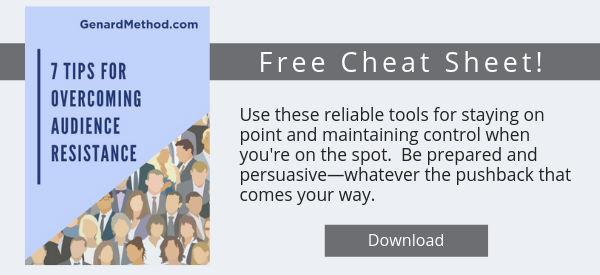We all know that getting an audience to accept and act on your message is easier if your listeners are receptive. Do they like you? Is what you’re saying pleasant for them to hear? Will the action expected of them from your presentation seem like a downhill journey?
Imagine on the other hand that the answer is “No” to each of those questions. Now, it’s just as likely that it’s going to seem like an uphill journey for you!
(You'll be much more likely to succeed if you don't use language that weakens your influence. Download my free cheat sheet, "25 Words or Phrases to Avoid in Speeches and Presentations.")
Your Approach Can Help Overcome Audience Resistance
Whenever possible—that is, when the conditions mentioned above are favorable for you—it’s a good idea to take a direct approach to delivering your message. That involves simply stating your message up front, then backing it up with evidence. The direct approach is effective and efficient, and is usually a productive strategy to use in organizing a speech.
When conditions aren’t so good for you, however, an indirect approach may be your best choice. Delivering your message indirectly means building your argument first, and only then stating the message that you think will be facing some resistance. It can be an equally smart strategy for speaking for leadership.
An Acronym for Public Speaking Success
Let’s put all of this into an acronym that can help foster persuasion and credibility when you speak, while increasing your influence. The four components of this acronym are as follows:
C = Credibility
B = Bias
S = Sensitive
A = Action
When most or all of these four conditions are in your favor, the direct approach to your message may be called for. That is, the variables would line up this way: your credibility is high; the audience is biased toward you; your message isn’t particularly sensitive; and the action you want your listeners to take is easy for them.
That’s the situation, for instance, with the CEO who announces to the company that a merger with a powerful parent company is about to take place, or the nominee delivering an acceptance speech at a political convention. On a more everyday level, it’s also the IT director telling her team that they’ve reached a new high in favorability ratings with their internal customers, and to continue their present effort.
In situations like these, delivering your message and then giving some evidence as to how this will all play out to everyone’s benefit is a wise choice. Why keep the good news on ice?
Your first step in succeeding with an audience, of course, is knowing who they are. Here's how to perform an audience analysis that will let you know what to say, and how to say it.
Understanding Your Task in Speaking to Persuade
But what about when conditions aren’t so favorable for you? Now you’re looking at the other side of the coin; and both what you say and when you say it may make a big difference in your effectiveness.
Once again, apply the CBSA acronym. Now, however, your credibility is low. The audience is biased against you. The topic is a sensitive one. And the action you want your listeners to take will be difficult for them.
What situations would look like that? It might be an HR director letting employees know that the company will be adopting a new health insurance plan with significantly higher co-pays. Or that CEO informing everyone that the merger didn’t go through. Or it might be a sales director letting his sales reps know that low sales have resulted in layoffs, and everyone’s territory is about to be doubled.
When your speaking situation looks like this, you may not want to deliver what everyone thinks is an unpleasant, sensitive, or difficult message up front. That’s especially true if the action required of your listeners is something they’d rather not do. Resistance is likely to kick in immediately, and your influence from this speech may be minimal at best.
How to Build a Compelling Argument
It’s much better in these conditions to first establish common ground, so listeners know that all of you share goals or interests. Then build your argument brick by brick, using the most compelling evidence you can muster.
(Do you know the 7 attributes of speaking for leadership that will help in situations like this? You can find them here.)
Only when you’ve done that should you unload your central message. At this point, your listeners may have a new or renewed sense that you’re in this thing together, that you share a common goal. And they’ll have seen you build a strong case right before their eyes. When the actionable message comes, it will be harder to dispute.
You may not win over everyone completely, and resistance will almost certainly still exist. In fact, if the conditions are unfavorable enough, it may seem to you like you didn’t make much progress at all. But if your strategy helps even a few people keep a more open mind toward what you're telling them, isn’t it worth the effort?
You should follow me on Twitter here.



